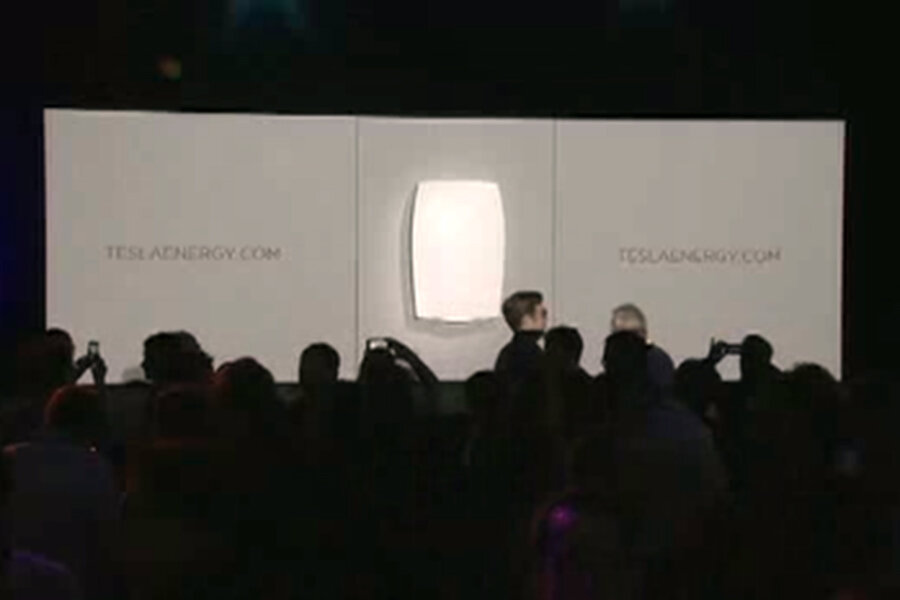Tesla reveals Powerwall units to bridge solar energy divide
Loading...
After months of teasing the new endeavor, Elon Musk, chief executive officer of Tesla, officially unveiled the carmaker's new battery-storage units Thursday night at an event titled “The Missing Piece.”
“Today, Tesla introduces Tesla Energy, a suite of batteries for homes, businesses, and utilities fostering a clean energy ecosystem and helping wean the world off fossil fuels,” the electronic automaker said in a press release.
Tesla showed off the different power storage systems for personal and industrial use, which are even accessible for utility companies. As the title of the event insinuates, Tesla believes that storage units will help bridge the gap for solar power to be widely used across the world.
“We’ve obviously been working on building a world-class battery, a super-efficient and affordable way to store energy,” said Khobi Brooklyn, a Tesla spokeswoman, as reported by the New York Times. “It’s just that we’ve been putting that battery in cars most of the time.”
All of the new batteries run on the same type of lithium-ion, software-equipped technology found in Tesla's cars, and can be mounted inside or outside of a building.
For homes, Tesla designed the Powerwall. Buyers who have solar panels installed on their roofs will get to choose between two sizes: the 10 kilowatt-hour pack for $3,500, which Musk says can potentially run a home if the power grid goes down, or the 7 kilowatt-hour pack for $3,000, which is ideal for daily uses. The units are rather large, with a starting weight of 220 pounds, and are about 3-by-4 feet wide and 6 inches thick. All units will come with a 10-year warranty.
“If you have the Tesla Powerwall, if the utility goes down, you still have power,” Mr. Musk said, adding “The whole thing is an integrated system that just works.”
For industrial or business use, Tesla created the Powerpack, which is equipped with the largest battery the motor company has ever made. Sizes for the storage unit will range from 100 kilowatt hour to 10 megawatt hour and higher. "Our goal here is to change the way the world uses energy at an extreme scale," Musk told reporters at the event, as the Verge reports.
Musk went on to explain that “the Powerpack is designed to scale to infinity,” and you could “literally make this into a gigawatt hour solution.”
Amazon, Target, and others have already singed on to use the large-scale energy storing systems.
The Powerwall and Powerpack will be manufactured in Nevada at Tesla’s Gigafactory, which is still under construction. But Musk hinted that he has big plans for the factory, which he sees more as a product that he hopes to expand. Musk told attendees of the event that with 160 million units, all of the US could be powered, and by building 2 billion energy storage batteries, the whole world could have access to reliable energy.
But even as Tesla becomes a leader in the green-energy movement, as Lux Research points out, the electronic carmaker will face certain hurdles before it achieves its ultimate dream.
“Tesla has succeeded in pushing down cell and pack costs for stationary energy storage, which will accelerate this market,” said Dean Frankel, an energy storage analyst at Lux Research in a news release. “However, power electronics, installation, and widespread availability of financing remain open questions. The quicker Tesla can build partnerships, make acquisitions, and invest further to address these issues, the better its chance of hitting its hugely ambitious goal of selling 15 GWh of stationary energy storage in 2020.”
While Tesla has become a leader with the current prices for stationary Li-ion packs at $350 a kWh, due in part to its partnership with Panasonic and its upcoming Gigafactory, installation costs “will nearly double the $3,000 price of Tesla’s entry-level Powerwall unit.” This is obviously problematic for the average consumer and Lux Research believes Tesla will need find a way to drive down these prices.
“Cheap cells made in the Gigafactory are only part of the puzzle,” Mr. Frankel went on to explain in the release. “Unlike electric vehicles, in stationary batteries there is more of a relative cost contribution coming from power electronics, software, and installation. Without more vertical integration – and perhaps even some acquisitions and Gigafactory-like efforts dedicated to inverters – Tesla is limiting its growth potential here.”
But the biggest roadblock for Tesla will be working with utility companies on expanding solar storage. As the news release explains, while its partnership with Southern California Edison and Oncor is a good start, to reach the “hundreds” of power providers needed to make the project truly successful will take time and resources, if the companies are even willing to play along.
Few utilities have taken an interest in the technology thus far and for good reason – green energy is threatening their monopoly on power. With consumers able to store energy during the day and rely on power providers less and less, the companies “will face declining demand and then bankruptcy,” as the Wall Post reports.
There are already several utility providers, including the Hawaiian Electric Company, lobbying to halt the progress of solar energy. In Arizona, there is a push for a $50 monthly fee for individuals who use solar, and, last year, Wisconsin approved fees for solar reliant individuals at an average of $182 a year.








